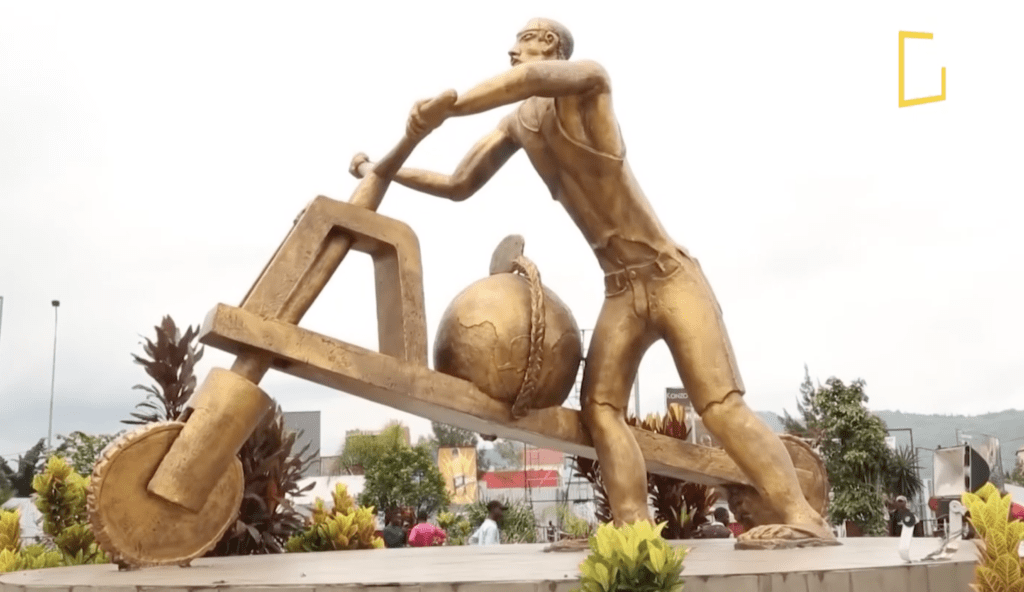Imagine a scooter, not just any scooter, but one crafted entirely from the finest African wood sourced from the Congo. This is the Chukudu, a remarkable invention that defies its primitive appearance, serving as a workhorse in the challenging terrains of the Congo. In this article, we delve into the history, craftsmanship, cultural significance, and enduring legacy of the Chukudu.
The Origin of Chukudu
The Chukudu has deep roots in the history of the Congo, where it has been used for centuries as a means of transportation. Its humble beginnings as a practical solution for traversing the rugged landscape have evolved into a symbol of local ingenuity and resilience.
Design and Construction
Crafting a Chukudu is not a simple task; it involves skilled artisans using traditional tools and techniques. The use of the finest African wood ensures both durability and a connection to the local environment. The handcrafted process is a celebration of craftsmanship, blending tradition with practicality.
Functionality and Capacity
Despite its seemingly basic design, the Chukudu boasts an impressive capacity, capable of carrying up to one ton of weight. It stands as a testament to the ingenious engineering that allows it to navigate challenging terrains while bearing substantial loads.
Aesthetic Appeal
Beyond its utilitarian function, the Chukudu is also a canvas for artistic expression. Each scooter is painted with intricate designs and patterns, reflecting the personality and style of its owner. This blend of functionality and aesthetics makes the Chukudu a unique cultural artifact.
Cultural Significance
The Chukudu isn’t confined to practical use alone. It plays a central role in local parades and festivals, where riders showcase their skills and compete for prizes. This cultural integration highlights the deep connection between the Chukudu and the people of the Congo.
Chukudu Monument

In recognition of the Chukudu’s significance, a monument stands tall as a tribute to this homemade scooter. Erected by the president, it symbolizes the hard work and persistence of the local people, immortalizing Chukudu as a cultural icon.
Comparisons to Modern Transportation
In a world dominated by modern vehicles, the Chukudu stands out. Contrasting it with contemporary scooters, we unveil the enduring relevance of this wooden marvel, challenging preconceived notions of what constitutes efficient transportation.
Chukudu in Daily Life
Surprisingly, the Chukudu continues to be a part of daily life in the 21st century. It has adapted to modern needs, showcasing its versatility and resilience in a rapidly changing world.
Challenges and Adaptations
While the Chukudu has faced challenges, innovative adaptations by users have allowed it to persist. From addressing terrain difficulties to incorporating modern elements, the Chukudu remains a vital part of transportation in the Congo.
Chukudu Beyond Congo
The appeal of the Chukudu isn’t limited to the Congo alone. Recognition and interest in this wooden scooter have transcended borders, captivating the curiosity of those beyond its place of origin.
Preserving the Chukudu Tradition
Efforts to protect and promote Chukudu craftsmanship involve local communities. Initiatives focus on maintaining the authenticity of the handcrafted process, ensuring the continued legacy of this unique mode of transportation.
Environmental Impact
In an era of environmental consciousness, the Chukudu’s use of wood for transportation raises questions about sustainability. We explore the environmental impact and compare it to other materials used in contemporary transport.
Chukudu in Media and Arts
The Chukudu’s influence extends to various forms of media and arts. From literary works to visual representations in film, it has become a cultural symbol, contributing to a broader global understanding of African heritage.
Conclusion
In conclusion, the Chukudu stands as a timeless marvel, defying conventional expectations of transportation. Its rich history, cultural significance, and enduring legacy make it a symbol of African ingenuity that has stood the test of time.
—————————————————————
Thanks for joining this wild ride. Stay curious, stay tuned, and let’s make our world brighter!
Check out the latest blog and video on YouTube and learn something new today.
Attention, all readers! To deepen your understanding and stay informed on the latest news and trends, be sure to click on the link to access more informative articles.
Join the family by liking us on Facebook, or follow us on Twitter and Instagram.
If you liked this story, sign up for the weekly OneMinuteExplore features newsletter called “The Essential List”. A handpicked selection of stories from OneMinute Nature, Wildlife, Culture, Travel, Stories, and more… delivered to your inbox every Weekend.
Yes, the Chukudu continues to be used in the Congo for transportation purposes.
A Chukudu is capable of carrying up to one ton of weight, showcasing its impressive load-bearing capacity.
Yes, there are initiatives involving local communities to protect and promote Chukudu craftsmanship.
The Chukudu’s use of traditional materials, handcrafted process, and cultural significance set it apart from contemporary scooters.
While its origin is in the Congo, the Chukudu has garnered recognition beyond its borders, sparking interest globally.













